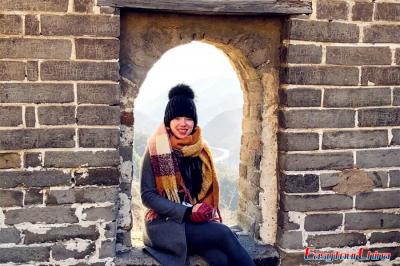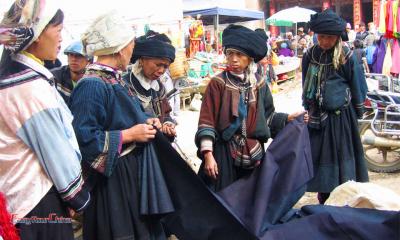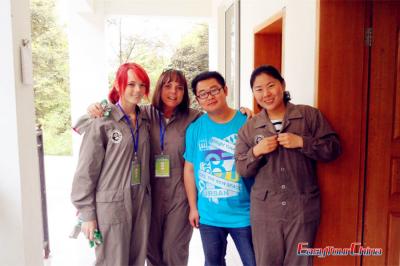China Textile and Handicrafts Tour for Women Travellers
Overview
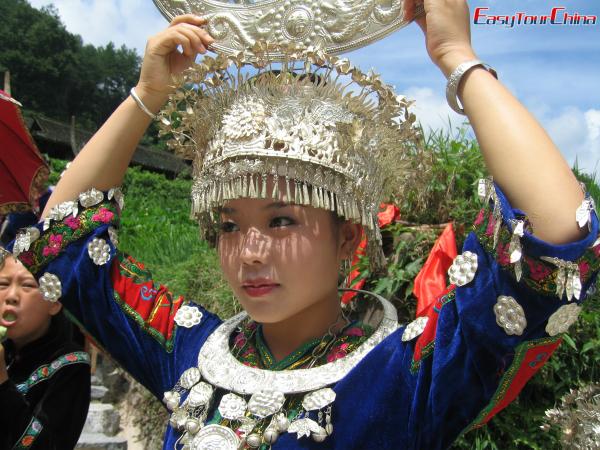
The 18 days China tour package for women is the ticket for you to learn Chinese textile, embroidery and traditional handicraft.
We believe a women’s tour in China is to connect and interact with local Chinese women, even those mysterious tribal women living in the remote mountainous areas. With this trip, apart from admiring the big-name attractions like the Great Wall, Terracotta Army and Li River, you can glimpse into ancient royal women’s life at Forbidden City, and learn techniques and skills of Cloisonné, Beijing Embroidery, shadow puppet, woodcut paintings, colored drawing on clay Sculpture - experience yourself the beautiful Chinese arts and folklore culture.
And then venture off to the Miao and Dong tribal kingdom of Guizhou, to meet women there and learn from them the exquisite silk embroidery, making of music instrument named Lusheng and indigo dyeing. There’re also great food tasting and cooking activities. With all these creating immersive local experiences for women, you will surely enjoy an unforgettable life-time journey.
Duration: 18 days & 17 nights
Destinations: Beijing - Xian - Guiyang - Kaili - Zhaoxing - Sanjiang - Guilin - Yangshuo - Shanghai
Travel Style: private tour
Customize Your Tour:
☑ Travel Dates ☑ Your Interests ☑ Your Travel Style
Itinerary Expand All
Welcome to Beijing, an enigmatical city amaze women travelers with its history, culture and traditional arts of China. There are two airports in Beijing. Beijing Capital International Airport is 25km (15.5 miles) north of the city center and the newly built Daxing International Airport is 53km (33 miles) south of Beijing city center. Send us your flight info and our guide will welcome you at the exit of the airport your flight will land and then transfer you to the hotel in downtown by private car. Rest of the day is free at leisure to acclimatize to your new time zone and environment.
As the must-see heritage site of China, the Forbidden City is your first stop, after a short walk at Tiananmen Square to its south. The year of 2020 is the 600th anniversary of its founding. Since 1925, it has changed from imperial palace to the Palace Museum. It is the best place to learn history, arts and architecture in ancient China. At Treasure Gallery, you will see the decorations for imperial women such as empress dowager, empresses, princess. You may also want to have a cup of coffee at Bingjiao Restaurant - the former imperial ice store house – interesting in-depth experience.
Walk out of the museum from north exit and have lunch in a local family in Hutong area. Sit in the traditional courtyard, you can have a free chat with the host, know some knowledge of the special house style and their family life. Continue your visit to Panjiayuan Antique Market after lunch. As Beijing’s biggest and best-known arts, crafts, and antiques market, it has been visited by many VIP, such as former first lady of USA Hillary Clinton, Sri Lankan President Chandrika Kumaratunga, and Thai Princess Sirindhorn. You might have a lot of questions to ask your guide, like “What is this for” or “How it works”. No problem, you will soon change to bargain stage, the most fun in the market and a skill mastered by almost all local women.
More energy left? We would like to suggest a show for you to relax, either Kungfu Show at Red Theater or Acrobatic Show at Chaoynag Theater is highly recommended. Just let your guide know what you’re interested in and he/she will help to arrange (not included and at your own expense).
Meal: B, L
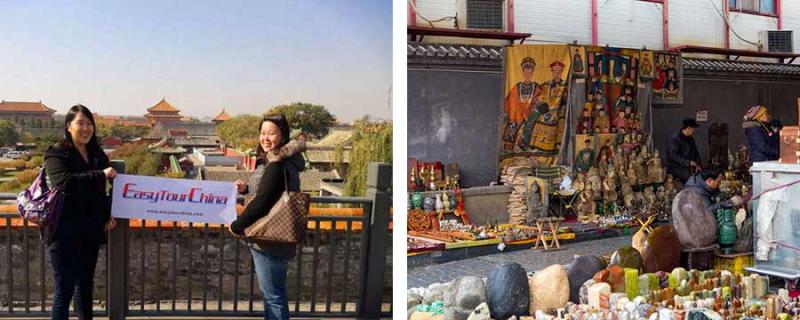
We will get out of the city area to the northeast and visit the Great Wall at Mutianyu, a section with fewer visitors than Badaling. You can choose to walk around 1.5km up to Tower 6, Tower 8 or Tower 10, or take cable car to Tower 14. Tower 20 of Mutianyu Great wall is the highest and the section before it is almost vertical and called Hero Slope. Take your time on the wall and enjoy picnic lunch on the Great Wall. You will have several choices to descend, by foot, take cable car at Tower 14, take chair-lift or slide down by toboggan at Tower 6. Cable car is a good choice for senior women travelers to save time and energy, while toboggan can bring great fun for young girls.
This afternoon, you will visit Cloisonné Art Museum of China to see the top traditional handicraft of Beijing. Cloisonné jewelry and ornaments were favored by women of Ming and Qing Dynasties. The manufacturing process of cloisonné integrates many professional techniques such as fine arts, carving, inlay, glass smelting and metallurgy and so on, carrying distinctive Chinese style and profound cultural connotation. You can view how craftsman work on different process and can even experience some of them with pre-arrangement by informing our travel consultant. Small cloisonné decorations with Chinese traditional design are also good souvenirs for female members in the family.
After a refreshing at hotel or a foot massage (at your own expense) to relieve after long walk, transfer to one of the best restaurants for Peking Roast Duck. With traditional Chinese decorations in the restaurant, you will have chance to view local opera performances when tasting the yummy foods.
Meal: B, L
This morning, we will go to visit The Museum of Ethnic Cultures. The museum has more than 20000 pieces (sets) of cultural relics of 14 categories, including production tools, daily necessities, religious utensils, clothing, antiques, documents, musical instruments, etc. Among them, highlights are traditional folk clothing and ornaments, which fully reflect the outstanding talents and exquisite skills of Chinese people of all ethnic groups in textile, printing and dyeing, embroidery, leather tanning, etc. Later in the villages you will visit, you may see some of them in ethnic people’s life.
Visit Temple of Heaven in the afternoon. Constructed from 1406 to 1420 during the reign of the Yongle Emperor, it worked as an imperial sacrificial altar in Ming and Qing dynasties. The Hall of Prayer for Good Harvests is a magnificent triple-gabled circular wooden building with no nails, which reflect the highest level of Chinese architecture and craftsmanship. Nowadays, the park is the place that local people, men and women, play or practice choral shows, ethnic dances, and other presentations. You’re always welcomed to join them if willing.
Following is time for local street food hunting at Wangfujing Snack Street. You can try most traditional Beijing snacks like Tanghulu (candied fruits on a stick), lamb Kebabs, bean soup and Muslim style sweet cake, etc. There are also different kinds of snacks from all over the country, like fried insects and stinky Toufu.
Meal: B, L
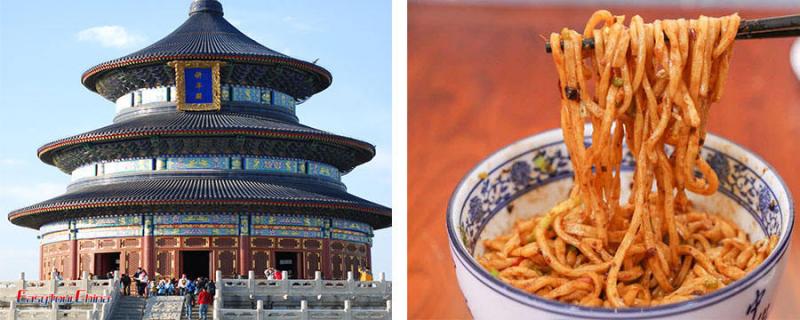
This morning, you will visit Baigongfang (the name means a workshop for 100 kinds of handicrafts), a handicrafts base for visitors to view masters of various areas that demonstrate their skills and train apprentices. You will have chance to visit workshop of Beijing Embroidery, which is also known as imperial embroidery. At paper-cut workshop, learn from the female masters on how to make a paper-cut from a piece of paper.
After lunch, take high speed train to Xian in the afternoon. The fastest train between Beijing and Xian is only 4.5 hours, with highest speed at 350km/hr or 218mph. Upon arrival, you will be met by your guide in Xian and then take private car to hotel check in.
Meal: B, L
This morning, you will be transferred to Lintong, 35km south to Xian city with around 1 hour driving. Visit the stunning Terracotta Warriors and Horses in the three pits that have been excavated. The mausoleum of Emperor Qinshihuang guarded by these warriors has not been excavated, but you can take a look from afar. Back to downtown in the afternoon and visit Small Goose Pagoda. You will view a short Shadow Puppet Play and learn how to make the puppets for the performance, which is one of the greatest handicrafts in Xian area. Afterwards, visit a local family and learn Dumpling making. A traditional Chinese dish, dumpling is a healthy diet for women who would like to keep fit.
Meal: B, L, D
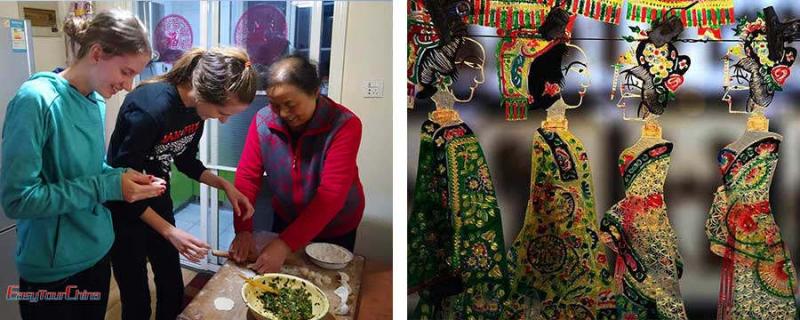
Today, we will take high speed train to get out of Xian city and explore a couple of villages in Fengxiang for their traditional handicrafts - Woodcut Paintings and Colored Drawing on Clay Sculpture. There might be similar handicrafts of Wood Engraving Pictures in other areas in China, such as in Yangjiabu, Yangliuqing and Zhuxianzhen, but the one in Fengxiang has long history since Tang Dynasty and with very typical local folk culture characters. Most of the pictures printed via woodcut are for New Year Festival, so it is also called Nianhua (年画) or New Year Festival Paintings. It was collected by many museums in the world and it is the first on to be printed on stamps. Fengxiang’s Painted Clay Sculpture is the exclusive handicraft in China. There are over 170 types of sculpture, like animals, facemasks, and people in folk stories, etc. Painted with China traditional colors, all sculptures are vivid arts. Tiger sculpture is one of the most popular.
Meal: B, L
Take flight to Guiyang and then take private car to Kaili, the capital of Qiandongnan Miao and Dong Autonomous Profecture. In this area, you will see Miao people and Dong people’s talented techniques on textile, embroidery and silver decorations, and witness local people’s, especially local women’s way of living.
On the way to Kaili, you will stop at Shiqiao Miao Village to see traditional paper making. With overy 1000 years’ experience in paper making by local tree named Kazinoki Papermulberry (Goupima tree) and unique water in Karst area, Shiqiao paper was one of the best one in China for Chinese brush painting and calligraphy. Shiqiao ancient paper is also selected as the paper for repairing ancient books and cultural relics by the National Library and the National Museum.
In Kaili, you will take a home stay in Langde Long-skirt Village where you can see girls dressed in unique traditional long-skirt and experience Miao people’s real life. You can try some farm works with the host in the rice field, vegetable plot or orchard, or cook their traditional foods.
You may want to know – What you need to avoid in Miao people’s family
1. Do not sit on the threshold.
2. Do not put your foot on the brandreth on the fire pit at the center of the room.
3. Do not whisle in the room or at night.
4. Do not call elder people directly with their names.
Meal: B, D
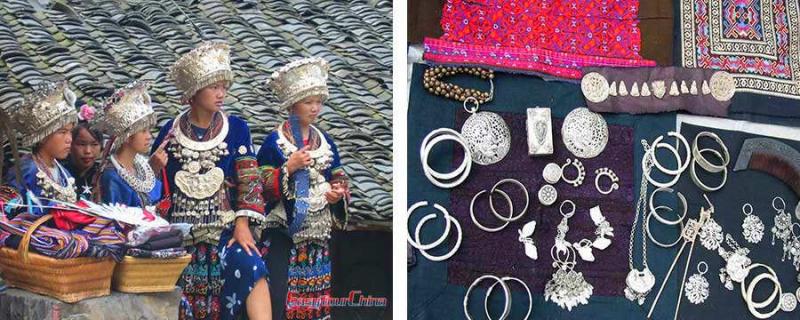
Take a walk in and around the village this morning. A Singing and Dancing performance by local villagers is available at the village square. You must be attracted by Miao women’s festival costumes, especially the embroideries and their shining silver decorations. You can see elder ladies in the village sit at the door and do their embroidery work. Silver decoration is the most important part of Miao girl’s dresses. After the performance, it’s time for us to explore the best handicrafts of silver processing of Miao people’s decoration in this area. Shidong Miao village is the center of the silver decoration producing in Guizhou. You will view very traditional way of the processing.
Back in the afternoon, and we will visit an embroidery workshop. You will see many beautiful costumes with brilliant embroideries collected from this area. And you will take a course to learn some techniques of Miao people’s embroidery, such as satin stich, braid embroidery, chain stich, etc.
Meal: B, L, D
Say goodbye to your host after breakfast and transfer to Paika, another Miao Village famous for the making of music instrument named Lusheng, which you have seen during the performance in Langde. There are many kinds of Lusheng, from small to a very large one. You will see how Miao craftsman process bamboo and assemble different bamboo pipes into a best popular music instrument. Continue to a mysterious village named Datang, which is also named Mini-Skirt Miao Village as it is said that all ladies in the village wear short skirt since 500-600 years’ ago. Their skirt is as short as 6.5-9 inches, but there are as much as 7 pleated layers and the most up to 20 layers.
Another highlight of this village is their wooden barns above water to prevent rats and fire. Next stop is a village noted for Silk Embroidery. This village is a migrant village by the road, as the original village is deep in the mountain with very difficult access to outside. With government’s support, villagers move out to new buildings and convenient transportation. Villagers raise silk worm and has developed very unique Silk Embroidery techniques.
After the visit, you will be driven another 4hrs to Zhaoxing, the largest Dong ethnic village. On the way, you may have chance to meet a traditional fair, which is held in a larger village every few days and people in nearby villages come to sell or buy things. See many men and women are dressed in their traditional clothes (perhaps their best clothes). Overnight in a cozy guesthouse in Zhaoxing Village.
Meal: B, L, D
Quiet in the evening, the village might become busy when visitors arrive after 10am. You can take a walk in the village in the morning and can see local people might wash clothes by the river and might notice that some women are smashing a pile of cloth with a wooden stick. Long clothes can be seen hanging all over the village. These are indigo clothes with very special processing by Dong people. Your guide will take you to a local people’s house and explain how they process indigo dyeing to make a shining cloth.
After lunch, you will drive to another village named Basha. People of this village use sickles to cut their hair, worship ancient trees and elemental forces, and have a traditional adult rite after which the young men are entitled to have their own guns that accompany them through life. Basha Miao Village is the only village that gun is allowed in China, so it also called the last gun tribe in China.
Meal: B, L, D
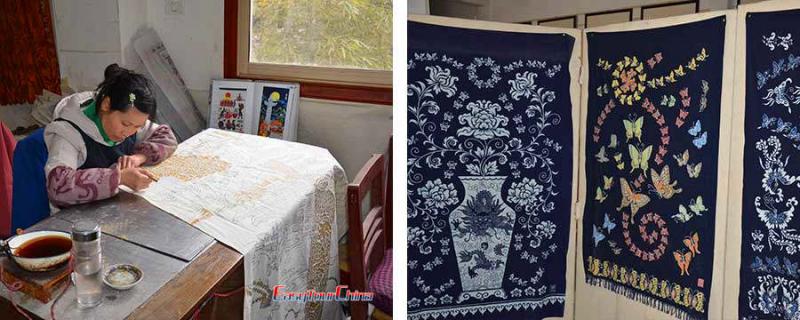
At around 10am, we will leave Zhaoxing for Chengyang, another Dong village in Guangxi Province. Main ethnic group in Guangxi is Zhuang people, but in the north area, there are many other ethnic groups like Dong, Yao and Miao. Drum Tower and the Wind & Rain Bridge are two most important buildings in Dong Villages. You have seen 5 large Drum Towers in Zhaoxing Village, and at Chengyang Village, you will view one of the most famous Wind & Rain Bridge named Yongji Bridge. 64.4 meters in length, the village was built with stone for pillars and wood for body and roof without a single nail.
In the afternoon, you will walk around the village and visit a local family to see the demonstration of cloth weaving by local women. Stay in the best guesthouse in the village which is transformed from an old wooden building with more than 100 years.
Meal: B, L, D
Transfer to Longji Pingan village in the morning and stop at half way to visit a local embroiderer good at making embroidery shoes (the local embroiderers are mostly women). You will learn paper-cut, the method of transferring a design to embroidery, and see how to make a pair of shoes. Continue to Ping’an village after the visit. This village is on hillside of the mountain with stunning view of rice terraces around it. Try your luck to view sunset on the rice terraces.
Meal: B, L, D
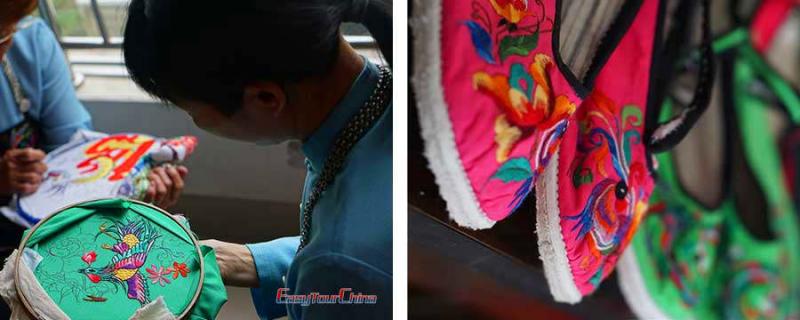
Zhuang people’s dress are more plain, but they are good at making embroidery balls, which are used to be a token expressing love between young boys and girls. A ball usually has 12 petals, or cone-shaped silk bags, which in ancient times were filled with red beans or grain before being embroidered with birds or flowers as a sign of good luck. This morning, you will learn how to make an embroidered ball. Descend after lunch and transfer to Guilin in the afternoon.
Meal: B, L
Guilin Karst, included in South China Karst, has been listed to the UNESCO World Heritage in 2014. Li River is the highlights of the Karst landscapes. Today, you will take the cruise downstream to Yangshuo to view the unique hills and bamboo groves along the river. After around 4hrs cruise with lunch on board, you will get to Yangshuo, a relaxing small town. Visit Fuli in the afternoon and take a course of painting fans making. Painting fans is a main industry of this village. In the old street, you will see many workshops are making different style of fans. All fans are hand-made and the most important process is painting and picture-mounting. You will learn Chinese brush painting first and then mounting it to the face of the fan.
Meal: B, L
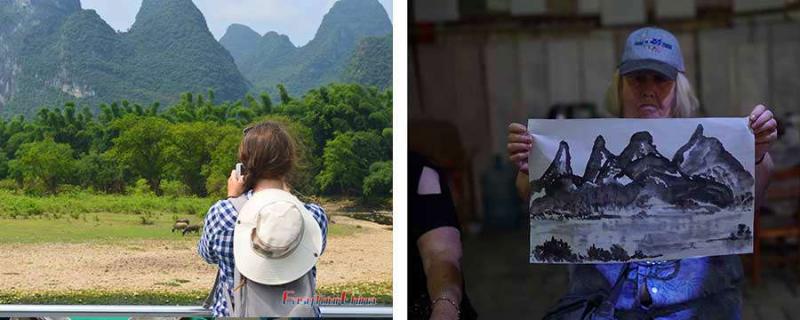
Free at leisure today to relax.
OPTIONAL ACTIVITIES
- Cooking class
- Rafting on Yulong River
- Countryside tour by bike
Meal: B
Picked up from hotel and transfer to airport for flight to Shanghai. Upon arrival in Shanghai, you will be met and transfer to hotel. Rest of the day is free at leisure for your own time to explore the city.
Meal: B
Picked up from hotel and transfer to airport for your flight back home. End of your 18 days textile and handicrafts tour of China.
Meal: B
